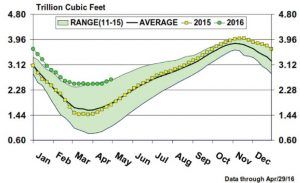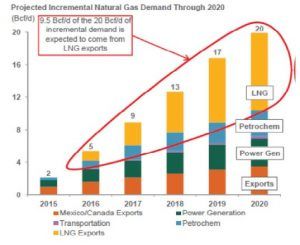Trends in US gas use
Attendees at the May gathering of the Pipeline Energy Group (PEG) at the Opal Sands Resort in Clearwater, Florida, were treated to briefings on a wide range of topics. Presenters included Engie (formerly GDF Suez), Exelon, OSIsoft, Columbia Pipeline Group, Yaskawa, Toshiba, Plains All-American Pipeline, Siemens, AEP Energy, Energy Transfer, Rockwell Automation, Lubrizol Specialty Products and Sulzer Pumps.

(Figure 1. U.S. natural gas storage levels have risen compared to the previous year)
Talks on the Electric Reliability Council of Texas (ERCOT), dual-driven compressors, centrifugal pump maintenance and the looming threat of cyber security were of particular interest to the turbomachinery industry.
ERCOT accounts for 90% of the Texas power load with 24 million consumers and 79,000 MW of generation. It has 43,000 miles of transmission lines and 550 generation units. “It is a healthy system with a high reserve margin,” said Andrew Elliott, Director of Supply & Portfolio Management for Engie," so price volatility is low and reliability high.”

(Figure 2: Natural gas demand will rise significantly in the coming years, particularly due to exports)
ERCOT prefers a 13.75% reserve margin, and its peak usage in August of 2015 was 70,000 MW. The region has managed to stay above its reserve threshold and is expected to do so for many years. But coal plant retirements may change the picture.
Gas dictates electric rates
Currently, 52% of ERCOT capacity is from natural gas, 22% from coal, 18% from wind and 6% form nuclear. As a result, gas tends to dictate electricity rates in the state. “As the gas price goes, so go electric prices in Texas,” said Elliott.
Natural gas and renewables will be future areas of growth in the Texas energy picture, particularly renewables, said Elliott. Currently, the state boasts 15.7 GW of wind capacity, and expects to erect another 3,000 MW more by 2018. Solar is far behind at 288 MW but could rise as high as 1,000 MW by the end of this year.
As for existing coal plants, he expressed concern about the regulatory picture. With Mercury and Air Toxics Standards (MATS) and the Cross-State Air Pollution Rule (CSAPR) already in force, and new rules concerning Regional Haze (calling for state and federal agencies to work together to improve visibility in 156 national parks and wilderness areas) and the Clean Power Plan (CPP) coming into play, coal plants may be required to add expensive scrubbers.
“Based on projected energy prices, the cost of these upgrades is not likely to be worth it for coal producers,” said Elliott. “But if ERCOT mothballs 5,610 MW of coal generation, it cuts the Texas reserve margin in half.”
Faced with regulatory pressure, how much lead time will generators give the market before they decide to shut these plants down? It takes two years to build a combined cycle power plant (CCPP).
Gas facilities have the advantage of price: It is around $2.00 per million BTU today and is not expected to increase to more than $3.00 by 2020. This has repercussions on the global liquefied natural gas (LNG) market. Not so long ago, LNG prices were as high as $15 in parts of Europe and Asia, but now are down to $6.
If gas costs $3, and another $3 or more to liquefy and transport it, that makes LNG exports only marginally profitable in some areas. With the exception of Mexico, low LNG prices may limit U.S. exports. If the LNG export facilities are built in time, up to 10% of U.S. gas may be exported. Additionally, gas prices in Mexico are about 50% higher than in the U.S., and pipeline capacity is being rapidly increased to enable gas from the U.S. to head south of the border.
“There are so many competing dynamics, as well as lots of lots of bullish and bearish indicators,” said Elliott. “Nothing is certain.”
Greg Kosier, Director of Commodity Management at Constellation, continued the discussion on markets. He noted that natural gas storage is currently at record high levels (nearing 2.8 Tcf) for this time of year (Figure 1).
The Sabine Pass LNG export facility on the Gulf Coast in Louisiana has already shipped eight cargoes to places such as Brazil, Argentina, Portugal, India and Dubai.
Kosier noted this represents the first meaningful exports LNG from the U.S. and is the precursor to significant growth in the years ahead. Four other LNG export terminals are in development, eventually taking U.S. export capacity to 9 Bcf per day. “
Due to lower LNG prices worldwide and increasing international growth in export capacity, it will be challenging for a sixth export facility to be built in the U.S. this decade, said Kosier.
Along with the growth in LNG exports, pipeline exports to Mexico will increase as 3.7 Bcf of pipeline capacity to Mexico is slated to come online in the next 18 months. Combining LNG with pipeline exports andplus of natural gas should be reduced. One forecast suggests that existing demand (78 Bcf/d in 2016) should approach 95 Bcf/d by 2020 (Figure 2).
(Read more in the July-August 2016 issue of Turbomachinery International magazine)
Fuel Flexibility in Heavy-Duty Gas Turbines: A Key Driver for Energy Transition
March 13th 2025From Hydrogen to HVO, Mr. Federico Bonzani, Chief Technology Officer of Ansaldo Energia, describes the fuel flexibility state-of-the-art solutions of the Company to meet the actual and future needs of power generation industry.